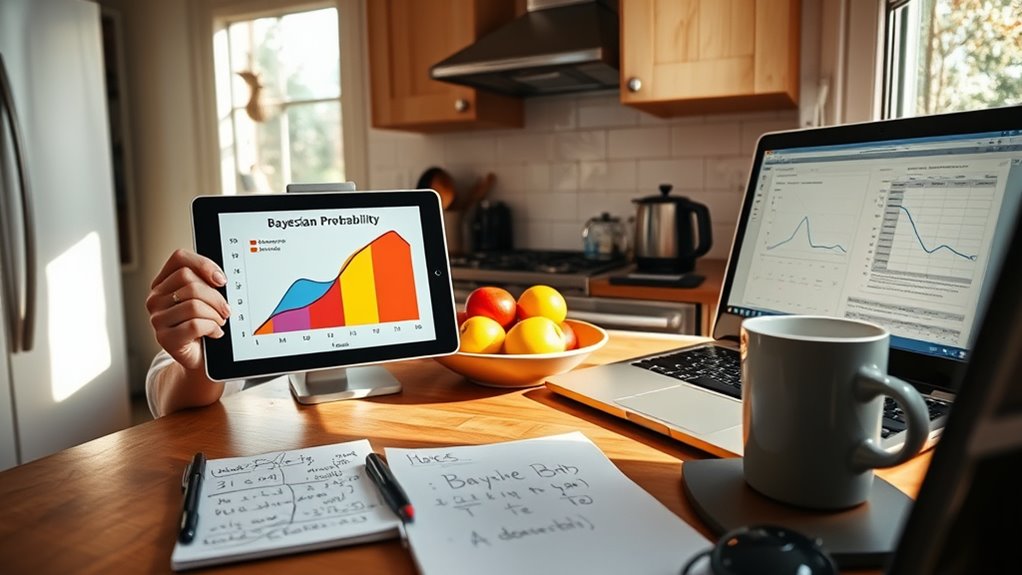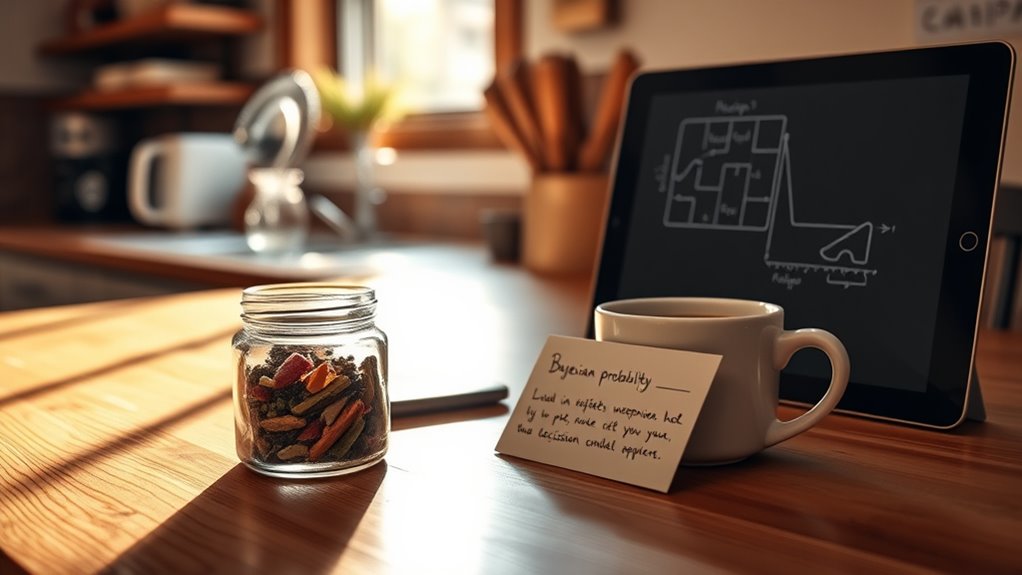Using Bayesian thinking in daily life helps you make smarter decisions by updating your beliefs with new information. Start with a guess based on what you already know, then gather evidence and adjust your thinking accordingly. This approach helps you evaluate risks better, avoid biases, and improve problem-solving. By applying this mindset regularly, you can approach everyday situations more rationally. Keep exploring to discover how to turn these ideas into practical habits that benefit you every day.
Key Takeaways
- Start with an initial assumption and update it as new evidence emerges daily.
- Systematically gather relevant information before adjusting your beliefs or decisions.
- Recognize how past experiences influence your current expectations and modify them with fresh data.
- Use a step-by-step approach to refine your judgments, avoiding overconfidence in initial beliefs.
- Practice regularly to become intuitive at updating probabilities and making more informed choices.

You are trained on data up to October 2023. Incorporating cultural symbolism and its significance can help you better understand the symbols and messages your dreams may be conveying in everyday situations. Recognizing common dream themes related to recurring dreams can also provide insight into unresolved issues or emotions that influence your waking life.
Frequently Asked Questions
How Can Bayesian Thinking Improve Everyday Decision-Making?
Bayesian thinking helps you improve everyday decisions by refining your intuitive judgments and reducing reliance on heuristic shortcuts that can lead to errors. When faced with uncertainty, you update your beliefs based on new evidence, making your decisions more accurate and informed. This approach encourages you to weigh probabilities carefully and adapt your thinking, leading to smarter choices and fewer mistakes, even in complex or unfamiliar situations.
What Are Common Misconceptions About Bayesian Probability?
Many misconceptions myths surround Bayesian probability, leading you to misunderstand its purpose. You might think it’s just about updating beliefs randomly or that it relies solely on complex calculations. In reality, Bayesian thinking helps you make better decisions by clarifying statistical misunderstandings and emphasizing how evidence impacts your beliefs. Recognizing these misconceptions enables you to apply Bayesian principles more accurately, improving your reasoning and decision-making skills in everyday life.
How Do I Start Applying Bayesian Reasoning Daily?
Ever thought your gut feeling is enough? Think again. To start applying Bayesian reasoning daily, embrace probability updates instead of relying solely on intuition. When you get new info, update your beliefs systematically. It’s like your mental GPS recalculating routes in real-time. This way, you align your intuition with actual data, making smarter decisions, whether predicting weather or judging a new project’s success. Bayesian thinking keeps you honest and sharp.
Can Bayesian Methods Help With Personal Financial Planning?
Yes, Bayesian methods can help you with personal financial planning by improving risk assessment and refining your investment strategies. You can update your beliefs about market trends as new information becomes available, making smarter decisions. This approach allows you to adapt quickly to changing conditions, better manage risks, and optimize your investments over time. Applying Bayesian thinking helps you stay proactive and informed, leading to more confident financial choices.
What Tools Assist in Practicing Bayesian Thinking Informally?
You can practice Bayesian thinking informally by using heuristic shortcuts and mental models to simplify complex problems. Tools like checklists, decision trees, and mental frameworks help you update beliefs based on new evidence. When faced with uncertainty, these tools encourage you to think critically and adjust your assumptions accordingly. By consistently applying heuristic shortcuts and mental models, you develop intuitive skills that make Bayesian thinking more natural in everyday situations.
Conclusion
So, next time you’re faced with a decision, remember that Bayesian thinking is like having a secret map guiding you through life’s uncertainties. It helps you update your beliefs with new clues, turning guesswork into informed choices. Think of it as your personal compass—pointing you in the right direction even when the path isn’t clear. Embrace this simple mindset, and watch how your confidence grows as you navigate life’s twists and turns.










